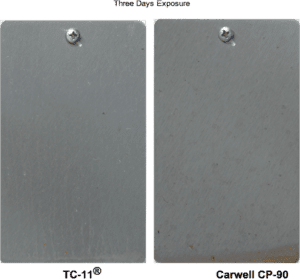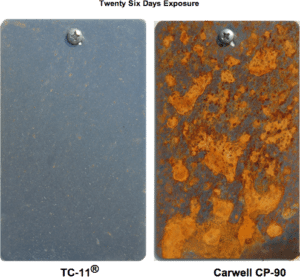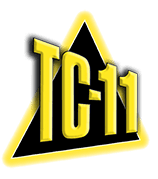The Competition
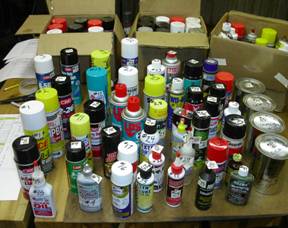 There are a lot of products on the market that make the claim, “Penetrates, Lubricates, and Protects”. They may offer some ability to do so, but in real world conditions usually they are not effective enough to justify their use. This has limited the use of corrosion inhibitors prior to the availability of TC-11.
There are a lot of products on the market that make the claim, “Penetrates, Lubricates, and Protects”. They may offer some ability to do so, but in real world conditions usually they are not effective enough to justify their use. This has limited the use of corrosion inhibitors prior to the availability of TC-11.
You may have tried a corrosion inhibitor before and stopped using it because it either evaporates and allows corrosion to take place or it hardens to form a wax film that interferes with the piece of equipment you want to protect.
TC-11 Has No Equal.
TC-11 offers a completely different level of corrosion inhibiting performance that significantly exceeds customer’s expectations.
Tests that accurately portray the performance of corrosion inhibitors in real world conditions using the following technique:
Standard steel test panels are chemically cleaned to provide a uniform level of corrosion.
- The panels are treated once with a competing product.
- The panels are mounted on a panel and exposed to exactly the same environmental exposure.
- The appearance of the panel is monitored by photographing the panel with a high resolution digital camera on a daily basis.
- The test procedure was designed so that any interested party can duplicate the results.
The photographs shown in each of the following tabs present the corrosion state of identical steel coupons that were treated once with a corrosion inhibitor and exposed to twenty-four hours per day of tropical sunlight, intermittent rain, a salt breeze, and a daily condensation cycle.
Visual Test Results of TC-11 vs the following competitive products:
WD-40
The coupon treated with WD-40 is showing signs of corrosion after three days of exposure. Based upon performance the price point for TC-11 should be $21.00 for an 11.8-ounce aerosol.
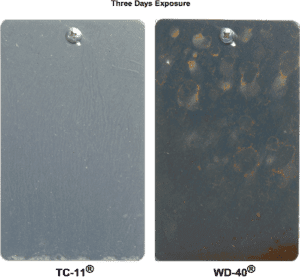
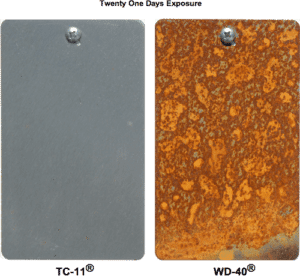
LPS-2
LPS-2® is one of the earliest corrosion inhibitors. LPS-2® offers performance that is similar to WD-40®. The photographs below present the corrosion state of identical steel coupons that were treated once with a corrosion inhibitor and exposed to twenty-four hours per day of tropical sunlight, intermittent rain, a salt breeze, and a daily condensation cycle.
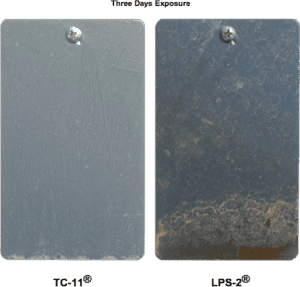
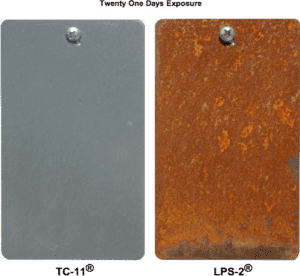
LPS-3
LPS-3® is a heavy duty version of LPS-2®. It is a wax based product, i.e. it forms a wax film. The wax film interferes with the operation of mechanisms, and can only be removed with a solvent. In addition, LPS-3 does not function as a lubricant or a penetrant. The photographs below present the corrosion state of identical steel coupons that were treated once with a corrosion inhibitor and exposed to 24 hours per day direct tropical sunlight, intermittent rain, a salt breeze, and a daily condensation cycle.
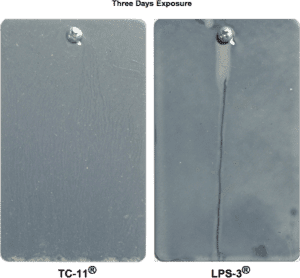
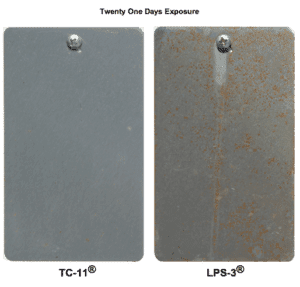
LPS® Heavy Duty Silicone
Many customers prefer silicone lubricants and corrosion inhibitors because they are “dry” and they “do not accumulate dust”. The reason that they are “dry” and “do not accumulate dust” is because they are not there! The photographs below present the corrosion state of identical steel coupons that were treated once with a corrosion inhibitor and exposed to direct sunlight, intermittent rain, a salt breeze, and a daily condensation cycle.
![]()
![]()
CRC® 3-36™
The photographs below present the corrosion state of identical steel coupons that were treated once with a corrosion inhibitor and exposed to direct sunlight, intermittent rain, a salt breeze, and a daily condensation cycle.
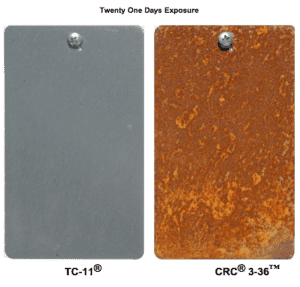
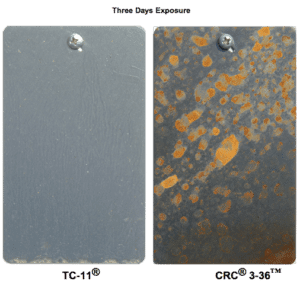
CRC® 6-56™
The following photographs present the corrosion state of identical steel coupons that were treated once with a corrosion inhibitor and exposed to direct sunlight, intermittent rain, a salt breeze, and a daily condensation cycle.
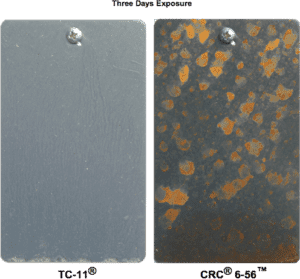
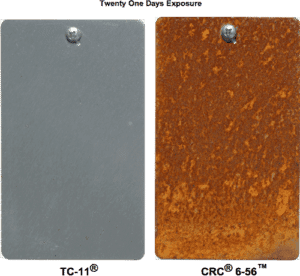
Tri-Flow
The photographs below present the corrosion state of identical steel coupons that were treated once with a corrosion inhibitor and exposed to direct sunlight, intermittent rain, a salt breeze, and a daily condensation cycle.
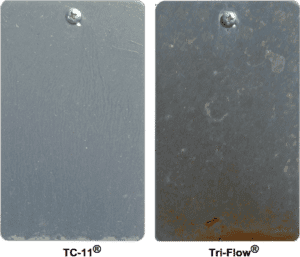
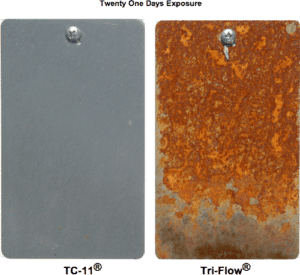
Corrosion Block®
The photographs below present the corrosion state of identical steel coupons that were treated once with a corrosion inhibitor and exposed to 24 hours per day of direct sunlight, intermittent rain, and a daily condensation cycle.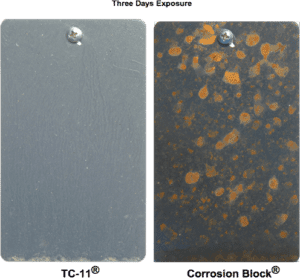
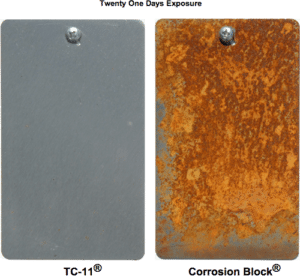
CorrosionX®
The photographs below present the corrosion state of identical steel coupons that were treated once with a corrosion inhibitor and exposed to direct sunlight, intermittent rain, a salt breeze, and a daily condensation cycle.
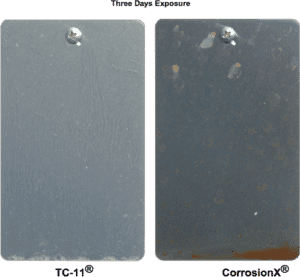
Boeshield® T-9
The photographs below present the corrosion state of identical steel coupons that were treated once with a corrosion inhibitor and exposed to direct sunlight, intermittent rain, a salt breeze, and a daily condensation cycle.
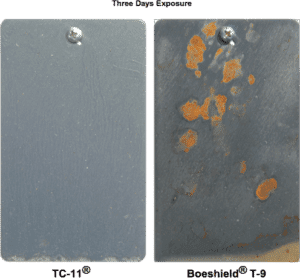
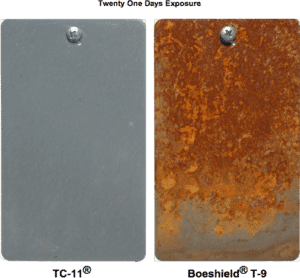
CRC® Heavy Duty Silicone
Many customers prefer silicone lubricants and corrosion inhibitors because they are “dry” and they “do not accumulate dust”. The reason that they are “dry” and “do not accumulate dust” is because they are not there! The photographs below indicate the condition of identical test panels that were treated once with a competing product and exposed to direct sunlight, intermittent rainfall, and a daily condensation cycle.
![]()
![]()
PB™Blaster®
The PB Blaster label states, “PB also displaces moisture and DOES NOT EVAPORATE. It remains on the surface as a LUBRICANT and RUST INHIBITOR”. The label also states, “CAUTION: PB B’LASTER may effect some plastics”, and it includes a demonstration of how effective PB Blaster is at melting styrofoam! The photographs below indicate the condition of identical test panels that were treated once with a competing product and exposed to direct sunlight, intermittent rainfall, and a daily condensation cycle.
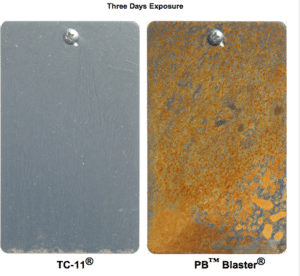
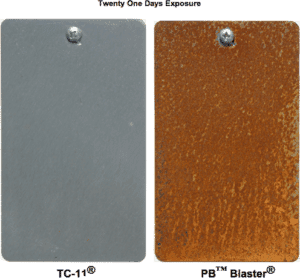
Valvoline® Synpower®
Valvoline®Synpower® Penetrating Lubricant makes the claim “Outperforms WD-40®for Lubrication (and) Rust Prevention”. The photographs below indicate the condition of identical test panels that were treated once with a competing product and exposed to direct sunlight, intermittent rainfall, and a daily condensation cycle.
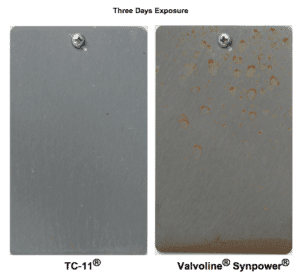
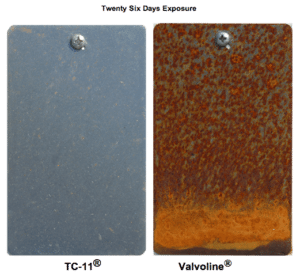
Amsoil® MP
Amsoil MP® makes the claim “Stops rust and corrosion. Form(s) a tough, protective film”. The photographs below indicate the condition of identical test panels that were treated once with a competing product and exposed to direct sunlight, intermittent rainfall, and a daily condensation cycle.
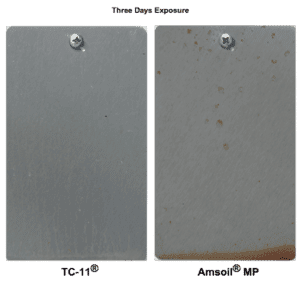
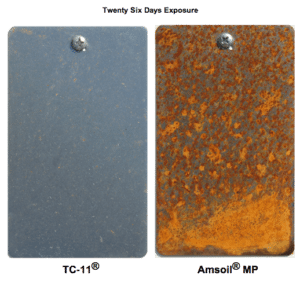
Carwell CP-90
The photographs below indicate the condition of identical test panels that were treated once with a competing product and exposed to direct sunlight, intermittent rainfall, and a daily condensation cycle.
